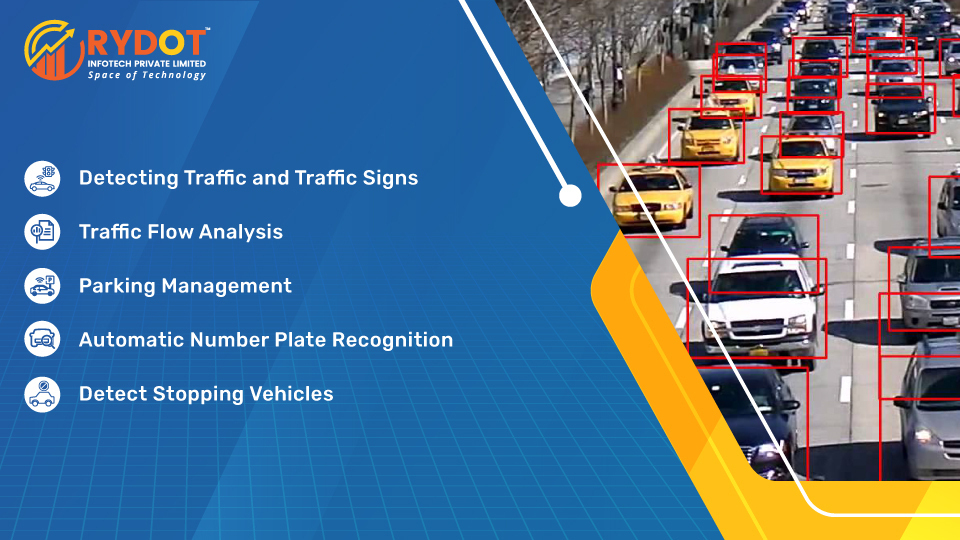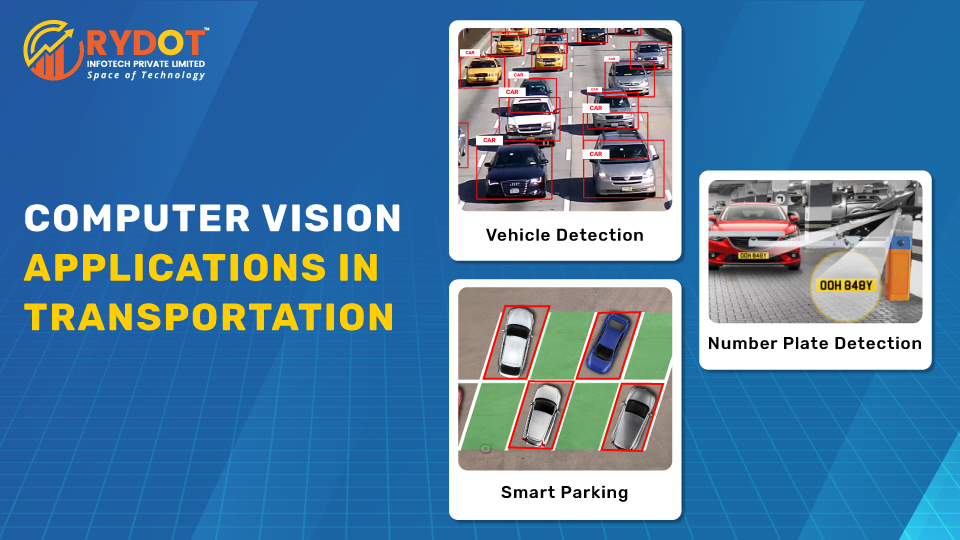![]()
Computer vision applications in transportation are becoming more widespread and trending. With the help of AI vision technology supply chain and transportation facilities are improving their efficiency and advancing their supply chain and logistics management system.
However, computer vision solutions have digitized the way transportation activities operate. Computer vision technology handles the entire flow of transportation from the flow of goods to the logistics process. In addition, it supports human operation in transportation with AI-visual.
Apart from this, computer vision in transportation is also useful to track real-time traffic and logistics movements using image detection and object detection technology that tracks the automatic number plate recognition and provides real-time movement.
This helps logistics management to take critical decisions easily by knowing the time taken to deliver which further improves logistics management.
Computer vision development services include fields like facial recognition technology, medical image analysis, self-driving cars, and intelligent video analytics. In the future, computer vision technology will continue to transform the transportation industry as it evolves and becomes more advanced. In this article, we will talk about what is the role of computer vision in transportation and what are the applications of computer vision in the transportation industry.
What is Computer Vision in Transportation?
Computer vision in transportation is the future of the transportation sector. Because it reduces the risk of accidents as well as helps in managing the logistics deliveries with cost-effectiveness.
With the help of Artificial intelligence, image detection, and object detection take place and are analyzed by the machine vision that people do.
As per the report, estimates say that over 1.35 million people worldwide die by accident each year. As a result, to avoid such transportation accidents companies in multiple industries such as healthcare, retail, security, manufacturing, and agriculture are using computer vision solutions effectively.
Read More: Top 8 Computer Vision Use Cases in Agriculture
How Computer Vision Is Transforming the Transportation Industry
Today, the logistics system is disrupted worldwide due to global issues and concerns have increased regarding effective transportation facilities. And that has increased concern regarding the transportation industry. On the other hand, big giant companies like Uber, Seven Drive, and Delivery are leading the way by utilizing computer vision applications in transportation. AI-vision technology is especially used to improve transportation facilities better than not just by facilitating real-time activities but also by increasing passenger safety, reducing traffic congestion, and lessen carbon emissions, and also minimize accident chances.
However, there are multiple types of computer vision technology in transportation that include image segmentation, object detection, facial recognition, edge detection, pattern detection, image classification, and feature matching. Currently, we are experiencing a significant breakthrough in transportation through Artificial Intelligence Solutions. AI technology is already transforming the transportation industry by detecting and classifying objects (e.g., road signs or traffic lights), creating 3D maps or motion estimation, and playing a key role in making autonomous vehicles a reality.
As per the report, “The global market for transportation-related AI technologies reached $1.2 to $1.4 billion in 2017. Further, it is expected to grow to $3.5 billion by 2023, at a compound annual growth rate (CAGR) of 12-14.5%.”
Application of computer vision in transportation
Corporates, industrialists, manufacturers, and the government are the biggest users of computer vision technology in transportation. It is more useful especially for the government to manage the traffic flow and provide smooth transportation facilities that can lead to economic growth later on. In addition, corporations and governments are developing their own AI-driven technology to improve their logistics and transportation efficiency.
However, there are multiple use cases of computer vision solutions such as…

1. Detect traffic and traffic signs
2. Traffic Flow analysis
3. Parking management
4. Automate number plate recognition
5. Detect stopping vehicle
1 Detect traffic and traffic signs:
Computer vision services are mostly used in traffic management that can help to save transportation time and fuel. By detecting the number of vehicles it can streamline the flow of traffic easily and manage the traffic signals easily. However, computer vision applications can also be connected with a camera to ITS (intelligence transportation system) so we can identify many types of incidents.
2 Traffic Flow analysis:
Problems in managing city traffic flow are increasing day by day. In Particular, congestion and crowding in cities have a negative impact including noise pollution, financial losses, green emissions, and so on.
However, with the help of AI-integrated drones and camera surveillance, identify the traffic flow and track the movement of vehicles that can alert the drivers in case of potential accident risk.
As a result, traffic monitoring solutions cover vehicle detection, speed, wrong way movement, stopped vehicle and other traffic violations detection.
3 Parking management:
Parking management makes it easier to find the available lots in real-time, where cars can be parked safely. The system identifies the occupancy and makes a mark on the available lots.
Often, when people visit airports, shopping malls, and hospitals. There is a huge shortage of parking and it occurs due to a lack of parking management. As a result, with the help of computer vision parking management becomes easy to manage parking facilities.
4 Automate number plate recognition:
ANPR (Automatic Number Plate Recognition) offers the optimal solution for efficient parking management. It allows registered vehicles to enter parking areas automatically, while non-registered vehicles can be identified based on their check-in and check-out times.
5 Detect stopping vehicle:
Unpredictable pedestrians are one of the biggest problems in identifying accidental risk. Thanks to computer vision technology and AI that can easily identify trees, diversions, and strange objects.
However, AI models can detect stopped vehicles during traffic surveillance. And give Real-time image processing of video feeds from surveillance cameras which is used to detect road safety problems.

